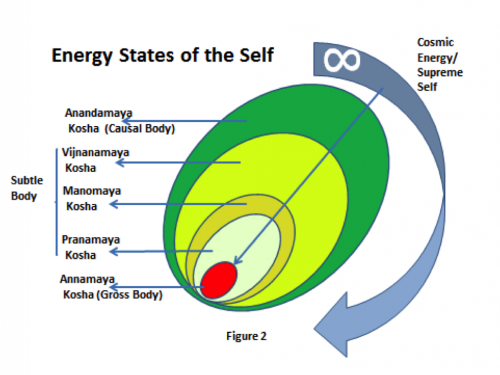While going through I found scriptures depicting about Pancha Kosha, suggesting the Atman is not just inside the physical body but is actually wrapped up in these Five Kosha.
What are these Pancha Kosha?
The Human body is actually a sheath or Kosha, if we dig deeper towards the soul(Atman), we find five distinct layers covering it, these are called the Five Sheaths or Pancha Kosha.
They are :
Annamay Kosha : Meaning 'Food Sheath', is the physical body, with hands, eyes, the body which has a name and dies. This is the gross, physical body. This is the sheath of the physical self, named from the fact that it is nourished by food.
Pranamaya Kosha : Meaning 'Life Air Sheath', contains the word Prana, which holds together the mind and body, its one physical manifestation is the breath.
Manomaya Kosha : Meaining 'Mind Sheath', the mind with five sesory organs are the physical manifestation of this Kosha.
Vijnanamaya Kosha : Meaning 'Intellect Kosha',composed of Vijnana, or intellect, the faculty which discriminates, determines or wills.
Anandamaya Kosha : Meaning 'Bliss Sheath', composed of ananda, or bliss,In deep sleep, when the mind and senses cease functioning, it still stands between the finite world and the self. Anandamaya, or that which is composed of Supreme bliss, is regarded as the innermost of all.
This Image describes the layers:

Along with these there are two more Koshas which are inherent in the Atman,
Chitta Maya Kosha : Body of consciousness.
Atma Maya Kosha : Body of Pure Spirit.
The subtle or metaphysical body of jivatma is said to be consisting of five different sheaths or layers known as pancha kosha. They are:
- Annamaya kośa — Food filled sheath
- Prāṇamaya kośa — Life air filled sheath
- Manōmaya kośa — Mind filled sheath
- Vijñānamaya kośa — Knowledge filled sheath (Intellect)
- Ānandamaya kośa — Bliss filled sheath
The atma is said to be covered by these five sheaths and the last one (bliss) is its true nature. The Taitariya Upanishad discusses about it in some more detail in a metaphorical way.